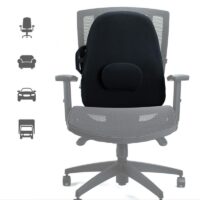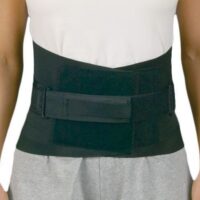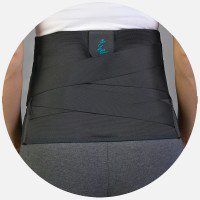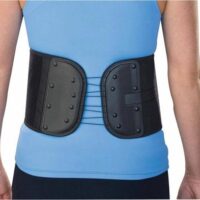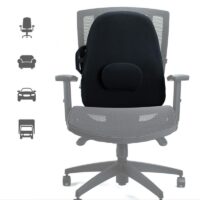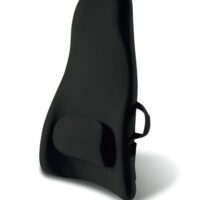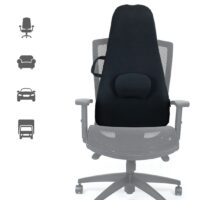Lumbar Facet Joint Pain
Article by John Miller

Lumbar Facet Joint Pain
What is Lumbar Facet Joint Pain?
Lumbar facet joint pain occurs when an injury affects the facet joints. The facet joints between the vertebrae of the spine are found in the cervical, thoracic, and lumbar regions of the spine, guiding and limiting the spine’s movement. Lumbar facet joint pain is a common cause of back pain.
What Causes Lumbar Facet Joint Pain?
Factors such as joint degeneration, injury, inflammation, and arthritis cause lumbar facet joint pain. Poor posture, stress, overuse injuries, aging, obesity, and genetics can also increase the risk. Locked joints, arthritis, osteophytes, joint capsule issues, muscle spasms, and degeneration can lead to facet joint hypomobility. Trauma, such as fractures, dislocations, overstretched ligaments, or diseases like Rheumatoid Arthritis, can cause facet joint hypermobility.
Locking a facet joint can occur from simple movements like a mild twist, awkward movement, or unexpected actions that the body is unprepared for, such as tripping. In most cases, this happens because the motion of the facet joint exceeds muscle control. Suppose there has been a previous injury or local muscle weakness supporting the facet joints. In that case, the locking of a facet joint can occur easier and repeatedly.
What are the Symptoms of a Locked Lumbar Facet Joint?
The symptoms of a locked lumbar facet joint can include pain, stiffness, and tenderness in the affected area. These symptoms may worsen with movement or specific activities. In addition to the lumbar region, individuals with lumbar facet joint pain may also experience referred pain in other body areas, including the buttocks, hips, or thighs.
When a facet joint locks, it restricts movement from the locked position. For example, if the joint is locked in a flexed forward position, it can be challenging to arch backwards. Compensatory movements by neighbouring joints may occur, leading to pain on the opposite side of the locked facet joint. This compensation could result in other conditions like sciatica. Decreased mobility and difficulty stretching are common as well.
Facet joint syndrome refers to the recurrent locking of a facet joint. Weak stability muscles that fail to control spine movement can cause lumbar facet joint pain. Suppose you experience symptoms of a locked lumbar facet joint or facet joint syndrome. In that case, it is crucial to seek medical attention to receive proper treatment and prevent further injury.
Diagnosis of Lumbar Facet Joint Pain
A qualified healthcare professional initiates lumbar facet joint pain diagnosis through a comprehensive medical history and physical examination. Various tests and assessments are performed during this evaluation to determine the range of motion, muscle strength and identify the source of pain.
While imaging tests like X-rays, CT scans, or MRI scans can detect arthritic changes and fractures, they are insufficient to confirm the diagnosis of a locked facet joint. The most accurate method of diagnosing a facet joint problem, whether locked, stiff, or unstable, is through a hands-on examination conducted by a qualified spinal physiotherapist.
It is crucial to consult with a healthcare professional to receive an accurate diagnosis and an appropriate treatment plan for lumbar facet joint pain. A tailored approach that addresses the underlying cause of the pain can effectively manage symptoms and improve the individual’s quality of life.
Lumbar Facet Joint Syndrome Treatment
To treat lumbar facet joint syndrome, a physiotherapist will perform a painless joint-releasing technique to unlock the locked facet joint. Once the diagnosis is confirmed, treatment options can include conservative measures like physiotherapy or medications and more invasive procedures such as facet joint injections or radiofrequency ablation. Sometimes, healthcare professionals may recommend surgery as a treatment option for lumbar facet joint pain.
After unlocking the joint, the focus shifts to regaining full motion and initiating exercises to prevent future recurrences. Your physiotherapist will customise the treatment plan based on the deficits identified during the examination.
Individuals with unstable facet joints require a different approach to treatment. Muscle control and stabilisation programs are necessary to address hypermobile facet joints, as a further loosening of the joint is unlikely to be beneficial.
It is essential to consult with a physiotherapist or doctor to obtain their professional opinion on the best treatment plan for your lumbar facet joint syndrome. They will provide personalised recommendations based on your specific condition and needs.
What Results Can You Expect?
Patients experiencing lumbar facet joint pain can expect significant symptom improvements through physiotherapy. According to a 2006 study by Hu et al., most patients achieve complete relief from pain after undergoing physiotherapy.
Patients with locked facet joints typically experience immediate improvement after the joint is unlocked. However, the extent and progression of progress depend on various factors, including the duration of joint locking, the underlying cause, and the range of motion available in adjacent joints.
In cases of facet joint instability, rehabilitation tends to be a lengthier process, emphasising muscle strengthening through a dedicated exercise program. A physiotherapist will provide specific guidelines and develop a personalised treatment plan to address individual needs.
It is essential to consult with a physiotherapist for an accurate diagnosis and an appropriate treatment plan. They will offer a professional opinion and provide insights into the expected results based on the chosen treatment approach.
Other Treatment Options
Other treatment options include:
Massage
Massage can effectively relieve muscle spasms, releasing facet joint spasms.
Acupuncture & Dry Needling
Localised acupuncture or dry needling techniques can help alleviate muscle spasms and relieve facet joint pain. Consult with your physiotherapist for more guidance on this option.
Facet Joint Injections
Facet joint injections can be a diagnostic tool and provide short-term relief (typically lasting a week or two). However, research suggests that exercise is more effective in achieving long-term relief than facet joint injections (Mayer et al., 2004).
Radiofrequency
In chronic cases that do not respond to physiotherapy treatment, healthcare professionals may consider radiofrequency treatment an option. Radiofrequency involves cauterising the nerve to provide pain relief for a certain period. However, one downside is that the pain often returns when the nerve regrows, typically within a few months.
It is essential to discuss these treatment options with your healthcare provider or physiotherapist to determine their suitability for your specific condition and to receive professional advice on the best course of action.
Conclusion
Lumbar facet joint pain can be a source of significant discomfort and limitations in daily life. However, with appropriate diagnosis and treatment, relief is achievable. Physiotherapy, including joint releasing techniques and exercise programs, is crucial in managing locked facet joints and addressing facet joint instability. Based on an individual’s needs and response to initial interventions, healthcare professionals may also consider other treatment options such as massage, acupuncture, facet joint injections, and radiofrequency.
Suppose you are experiencing lumbar facet joint pain symptoms or suspect you may have a locked facet joint. In that case, it is crucial to seek medical attention. Consult with a healthcare professional, such as a physiotherapist or doctor, to receive an accurate diagnosis and develop an effective treatment plan. Remember, early intervention and appropriate management can significantly improve your symptoms and quality of life. Don’t hesitate to take the first step towards addressing lumbar facet joint pain and reclaiming your comfort and mobility.
Rochedale - Call 38410277
Book Online: RochedaleSalisbury - Call 32751044
Book Online: SalisburySandgate - Call 32691122
Book Online: SandgateWhat Causes Lower Back Pain?
Introduction
Lower back pain is a widespread issue in Australia, stemming from diverse conditions. As physiotherapists, we often encounter various causes of this pain. This guide aims to shed light on these causes and provide valuable insights for effective management.
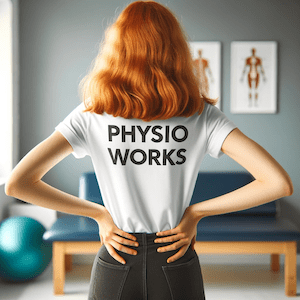

Muscle-Related Injuries
Muscle injuries are a predominant cause of lower back pain, including:
- Back Cramps and Muscle Pain: Typically resulting from overuse or strain.
- Core Stability Deficiency: Weak core muscles can lead to increased back strain.
- DOMS (Delayed Onset Muscle Soreness): Soreness affecting back muscles post-exercise.
Recent research underscores the importance of regular exercise and core strengthening in preventing these injuries.
Bone-Related Injuries
Bone health is crucial in lower back pain, encompassing conditions like:
- Spondylosis: Degenerative spine conditions.
- Spondylolysis or Stress Fracture: Common in athletes, such as cricket bowlers.
- Spondylolisthesis: Occurs when a vertebra slips over another.
- Osteoporosis: Causes bones to weaken, increasing fracture risk. Advancements in bone density scanning have improved early detection and management.
- Scheuermann’s Disease: Affects spinal bone growth in teenagers.
- Scoliosis: An abnormal curvature of the spine causing pain.
- Spinal Stenosis: A narrowing of the spinal canal leading to nerve compression.
Disc-Related Injuries
Spinal discs are vital for spinal health:
- Bulging and Disc Protrusions: These discs protrude or "slip" and can press on nerves.
- Herniated Disc: A more severe form of disc protrusion.
- Degenerative Disc Disease: Age-related disc wear and tear.
Minimally invasive surgical techniques have transformed the treatment of severe disc-related injuries where physiotherapy and other non-operative options fail to improve.
Back Joint Injuries
- Facet Joint Pain: Arises from arthritis or stress on these spinal joints.
Nerve-Related Injuries
Nerve issues can lead to:
- Nerve Pain and Pinched Nerves: Caused by spinal nerve compression from disc bulging or arthritic changes.
- Sciatica: Irritation of the sciatic nerve.
Physiotherapy and newer medications have been effective in managing these conditions. Some will require injection therapies or surgery.
Pelvis-Related Injuries
Pelvic issues also contribute to lower back pain:
- Sacroiliac Joint Pain: Involving joints connecting the spine to the pelvis.
- Piriformis Syndrome: Where the piriformis muscle irritates the sciatic nerve.
Pregnancy-Related Pain
- Pregnancy Back Pain: Often due to increased back strain during pregnancy. Prenatal physiotherapy programs are beneficial.
Systemic Diseases
Systemic diseases like Ankylosing Spondylitis, Fibromyalgia and Rheumatoid Arthritis can cause back pain.
Recent Research and Advancements
Current research emphasises a holistic approach to treating lower back pain. Techniques like yoga and Pilates, alongside traditional physiotherapy, and conservatively progressed gym programs show significant relief. The role of diet in managing weight and inflammation is increasingly recognised.
Best Treatments for Lower Back Pain
Treatment varies but often includes:
- Physiotherapy
- Pain management
- Strength and flexibility exercise programs
- Ergonomic adjustments
- Surgical interventions for severe cases
Conclusion
Lower back pain is a significant health concern in Australia. Understanding its causes and seeking professional physiotherapy advice can greatly improve life quality. Remember, early intervention is key for an effective recovery.
What to Do?
If you're experiencing lower back pain, it's vital to consult a physiotherapist or doctor. They can provide an assessment and customised treatment plan based on your specific condition.
Rochedale - Call 38410277
Book Online: RochedaleSalisbury - Call 32751044
Book Online: SalisburySandgate - Call 32691122
Book Online: SandgateBack Pain FAQs: What to Do? When?
Back pain is one of the most common health concerns, affecting countless Australians every year. Whether it's a dull ache or a sharp pain, back pain can significantly impact your quality of life. In this FAQ, we'll explore why back pain occurs, how it can be treated, and what steps you can take to prevent it. Each section below includes helpful links to more detailed articles on our website, making it easy to find the information you need.
Why Does Back Pain Occur?
Back pain can result from various causes, including muscle strains, herniated discs, or underlying health conditions. Understanding the root cause of your pain is crucial in determining the most effective treatment.
- Most Common Causes of Severe Back Pain
Discover the primary reasons behind back pain and how they affect your daily life. Learn more about severe back pain causes. - Causes of Lower Back Pain
Learn about the specific factors contributing to lower back pain and how to address them. Explore the causes of lower back pain. - Causes of Upper Back Pain
Upper back pain can be particularly challenging. Find out what's causing your discomfort and how to alleviate it. Find out more about upper back pain.


How Can Back Pain Be Treated?
A variety of treatments can help alleviate back pain, from physiotherapy to targeted exercises. Knowing your options is the first step toward effective relief.
- Best Treatment for Lower Back Pain
Discover the most effective treatments for alleviating lower back pain. Check out the best back treatments. - Physiotherapy for Back Pain
Physiotherapy offers a comprehensive approach to managing and reducing back pain. Learn about physiotherapy options. - Exercises for Back Strength
Strengthening your back through exercise is key to both treatment and prevention. Discover back-strengthening exercises.
What Are the Prevention Tips for Back Pain?
Preventing back pain before it starts is often the best strategy. Incorporating healthy habits into your daily routine can make a world of difference.
- Preventing Back Pain Tips
Simple lifestyle changes can significantly reduce your risk of back pain. Read back pain prevention tips. - Proper Back Posture Guidelines
Maintaining good posture is essential in preventing back pain. Understand proper posture. - Regular Exercise Routines for Back Pain
Consistent exercise can keep your back healthy and pain-free. Find back exercise routines.
When Should You See a Physio or Doctor for Back Pain?
It's important to know when back pain requires professional help. Recognising the signs can lead to more effective treatment and a quicker recovery.
- Severe Back Pain? Causes, Symptoms & Treatment
Identify severe back pain symptoms and the appropriate treatments. Learn about severe back pain. - Warning Signs of Severe Back Conditions
Some back pain signals a more serious condition. Learn when to seek medical attention. Recognise warning signs. - Physiotherapy Consultation for Back Pain: What to Expect?
Understand what happens during a physiotherapy consultation for back pain. What to expect at your physio consultation.
What Can Be Done for Repeated Bouts & Incidental Back Pain?
Recurring back pain can be particularly frustrating. By understanding the underlying causes, you can take steps to manage and prevent future episodes.
- Causes of Recurrent Back Strains
Learn why back strains keep coming back and how to stop them. Explore recurrent back strain causes. - What Causes Repeat Low Back Strains & Sprains?
Repeated low back issues can stem from various factors. Understanding these can help in managing the pain. Find out more about low back strains.
Conclusion
Arming yourself with knowledge about back pain can empower you to make informed decisions about your health. Whether you’re experiencing pain now or want to prevent it in the future, taking proactive steps can make all the difference.


Rochedale - Call 38410277
Book Online: RochedaleSalisbury - Call 32751044
Book Online: SalisburySandgate - Call 32691122
Book Online: SandgateCommon Back Pain FAQs
- Why does back pain occur?
Back pain can occur due to muscle strains, herniated discs, or underlying medical conditions. Identifying the cause is essential for effective treatment. - How can I treat back pain at home?
Mild back pain can often be managed with rest, gentle exercise, and over-the-counter pain relievers. Physiotherapy is recommended for ongoing issues. - What are the best exercises for back pain?
Strengthening exercises like planks, bridges, and gentle stretching can help prevent and reduce back pain. Consult a physiotherapist for personalised advice. - When should I see a doctor for back pain?
Seek medical attention if your back pain is severe, persistent, or accompanied by symptoms like numbness, tingling, or weakness in the legs. - What are the most common causes of lower back pain?
Lower back pain is often caused by poor posture, lifting heavy objects, or sitting for long periods. Muscle imbalances and herniated discs can also be factors. - Can physiotherapy help with back pain?
Yes, physiotherapy can significantly reduce back pain by improving mobility, strengthening muscles, and addressing the root causes of pain.
Related Articles:
- Causes of Lower Back Pain: Discover the common causes and symptoms of lower back pain.
- Best Treatment for Lower Back Pain: Explore the most effective treatment options for lower back pain.
- Physiotherapy for Back Pain: Learn how physiotherapy can provide relief for back pain sufferers.
- Exercises for Back Strength: Strengthen your back with these targeted exercises.
- Preventing Back Pain Tips: Tips on how to prevent back pain before it starts.
- Understanding Herniated Discs: Learn about herniated discs and how they cause back pain.
- Benefits of Back Massage: Explore the therapeutic benefits of back massage.
- Severe Back Pain? Causes, Symptoms & Treatment: Identify and treat severe back pain effectively.
- Proper Back Posture Guidelines: Improve your posture to reduce back pain.
- Walking and Back Pain: Understand the impact of walking on your back health.
- Back Pain - This Mayo article discusses the symptoms, causes, and treatments for back pain.
- Understanding Back Pain - WebMD offers a comprehensive guide to understanding back pain, including treatment options and prevention strategies.
- Back Pain Overview - Healthline provides an overview of back pain, its causes, treatments, and prevention tips.




